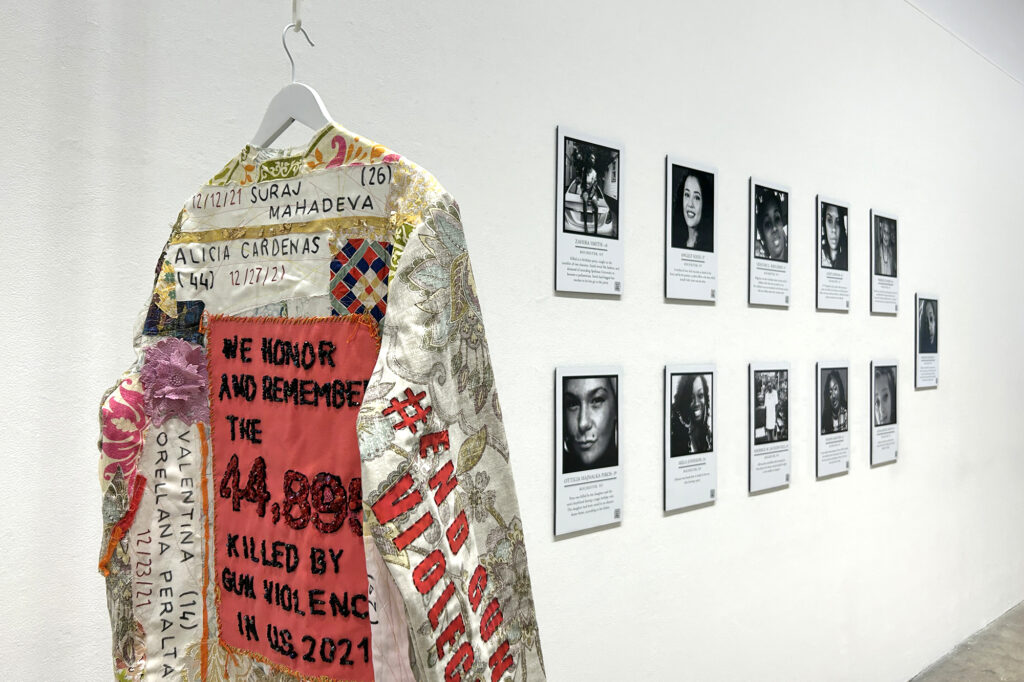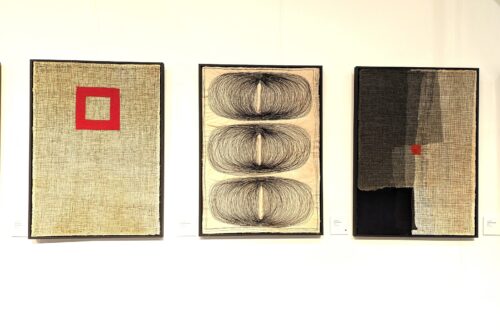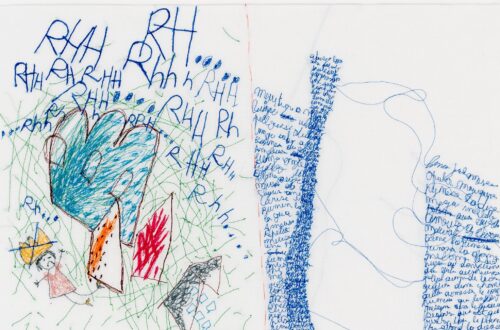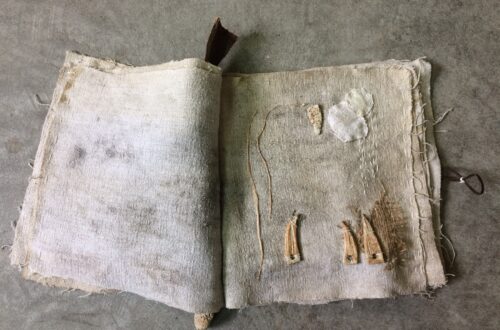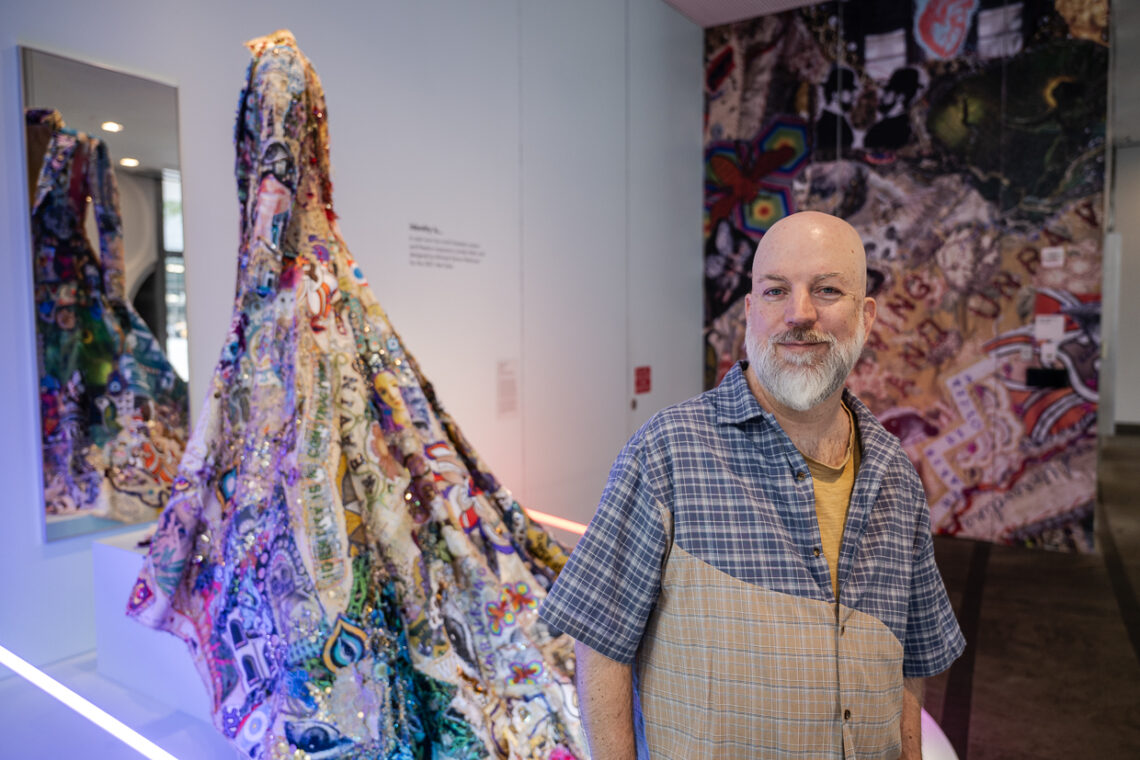
MICHAEL SYLVAN ROBINSON
Michael Sylvan Robinson’s art and queer activism are expressed through the innovative use of textile collage and text-based art techniques. Their process begins with the selection of textiles characterized by intricate patterns, which are then reassembled into complex textile collages, densely worked with machine and hand stitching, as well as bead applications.
Originally a costume designer and performance artist, Robinson’s practice later evolved into a deep exploration of wearable art, two-dimensional works, sculptures, and installations. In these works, the dimensional aspect is heightened by meticulous surface details that invite the viewer to engage with a broader conceptual structure. The sculptural garments and wearable art from their #urbanfey series serve as interventions of care, healing, and artivism, addressing the challenging times in which we live.
Each piece is layered with imagery that is both queer and wild, yet deeply connected to the urban landscapes of the environment in which Robinson grew up. Hand-stenciled poetic text fragments printed on the garments express intentions, offer reflections on the fragility of the world, and evoke a call to remembrance and, at the same time, action.
They shared insights about their work in this fascinating interview
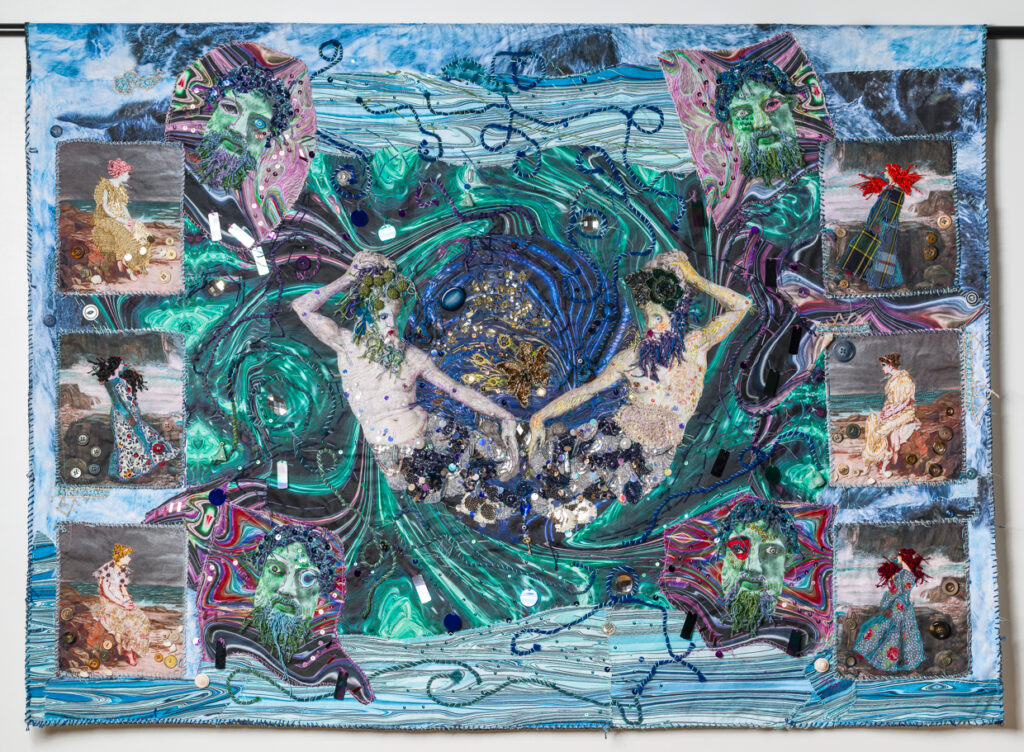
Genderqueer fiber artist, activist, art educator: can you tell me who is the artist Michael Sylvan Robinson and how his artistic practice talk about him?
I’m addressed Sylvan, using my full name professionally and for listings, but just Sylvan when we’re in conversation together. I use they / he pronouns. I’ve known myself as genderqueer for most of my life, though there have been times I kept that understanding more hidden from outward expression, and now at midlife feel very inspired and renewed in my self-embodiment in this generational expansion of gender expression and identity.
My work in the world is really an intersection of art, activism, and arts education, and all three of those pathways twined together in my early formative years as a young queer person in New York City of the late 80’s and early 90’s. Initially, I was a costume designer, a performance artist, and drag performer, and those experiences provided a great foundation for my fiber art practice of today! During those early NYC years, I participated in Queer Nation and ACT UP meetings and actions as many of my friends were dying of AIDS complications; being of service, caring for others and community, anchored much of my development as a person. Today, I’m an active member of Gays Against Guns, a nonviolent direct action group trying to stop the epidemic of gun violence. I bring my art to that work, creating memorial garments that have been worn in actions and memorial vigils. I research those killed by gun violence, and I try to share what I can learn about each individual’s life so that they are honored and remembered by our activism.
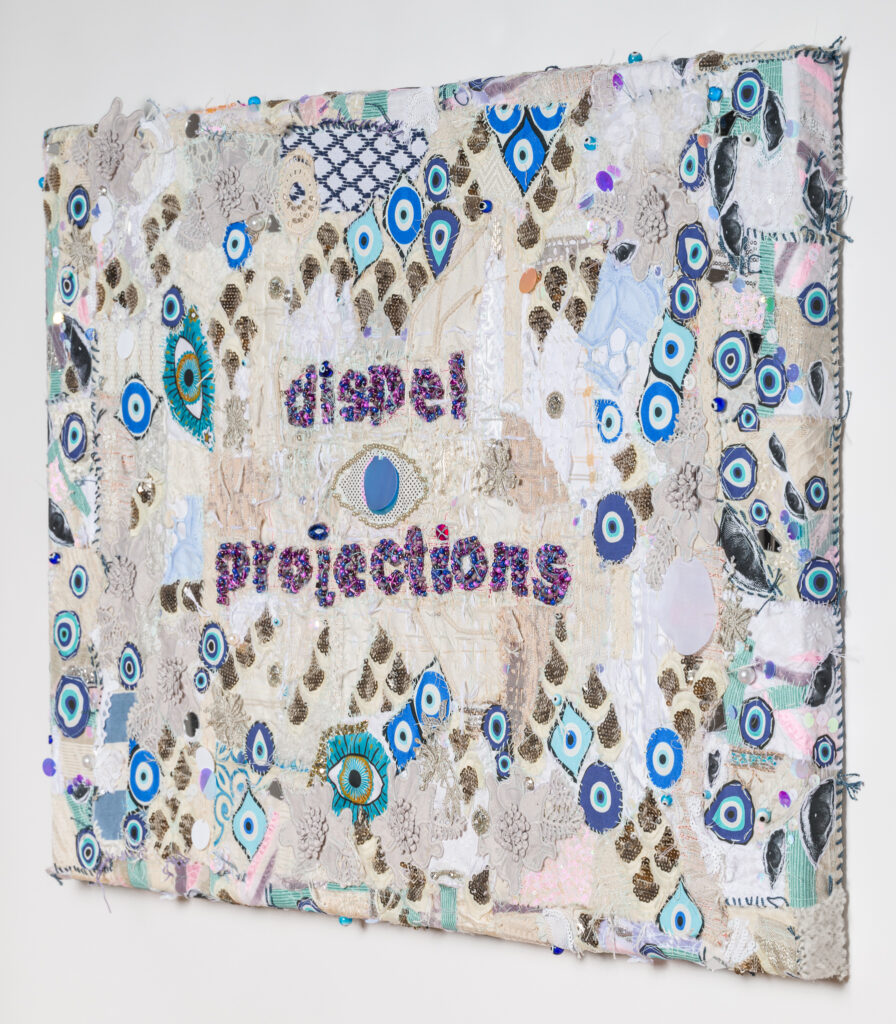
Where does your predilection for the textile medium come from – where and when did it begin?
One of the places I felt safest at college was the costume shop. As a young person I was very inspired by fashion and costumes, and as an 80’s teen there were so many gender noncomforming icons to be inspired by – Boy George, Annie Lennox, Prince – were some of the first music videos I remember seeing, and I wore makeup and deliberately genderfluid clothing during those years as I explored my creativity and personal identity. When I went back to earn an MFA at Goddard College, I turned my costume design and construction skills towards a more visual arts focused practice. I attended a professional development conference in Baltimore as part of my teaching work, and one of the presenters was the incredible Joyce J. Scott, she shared her interdisciplinary artistry and love of materials, including beadwork; I walked over to a local bead store right after the conference and came home with my first jars of brightly colored glass beads, which are an important component of my work to this day. I’m drawn to the decorative as a way of delighting the eye, but the beauty of my work is also an invitation to encounter the activist messaging or more challenging thematic projects that are part of my art-making.
Handwork is a major aspect of all my art-making; it is labor intensive, and sometimes I feel very much like a kind of faerie spider eagerly stitching away in bright colors and sparkling beads, and other times it feels very much like Rumplestiltskin spinning straw into gold with faster, tighter deadlines. My studio is in my home, and it helps me keep long-term projects moving even if I just get a little time in the studio when I get back from school.
Body, dress, identity: what do you think is the relationship between these elements and how are they declined in your works?
Often my work is about the absence of the body, creating sculptural garments that are memorial pieces, marking absences. My “Mourning Jacket for a Sweet Satyr: In Remembrance of Eric J. Ginman 11/13/69-7/19/97” was originally shared as a costume piece for the 2019 Bennington College 24 Hour Play Event, and through an amazing collaborative process with playwright Maia Villa and director David Drake, the memorial garment was incorporated into a new short play, Remembrance. This opportunity shifted me back into making clothing, and the piece was later shown at the Wisconsin Museum of Quilts and Fiber Arts. Eric and I were lovers both before I graduated from Bennington College and afterwards, and he died five years after his own graduation, in 1997 of complications from AIDS before he reached the age of 30. He’d sent me beautiful self-portraits which I held privately for years and then had printed onto silk as part of the textile collage process for this piece. Sometimes one puts the mourning down until there is space and presence to return to the ache of grief.
Initially when I returned back to the body, it was making activist and specifically memorial works to wear to actions and protests against gun violence as part of my work with Gays Against Guns, a nonviolent direct action group combatting the gun violence epidemic in the United States. I’m continuing a series of wearable art garments that arise from my ongoing research identifying and honoring individuals killed by guns, now starting a third year-specific memorial garment. I’ve worn these garments as part of actions and vigils, but more frequently they are displayed without someone wearing them which provides the viewer a sense of the empty spaces once held by the living.
Lately, I’m also making clothing that is fashion art with activist messaging through use of hand-embroidered or hand-beaded text; most notably showcased in the elaborate textile collage garment I designed for theater producer, Jordan Roth, to wear to the Met Gala in September, 2021, which was inspired by Roth’s original prose describing gender expression and identity worn like a garment, always in a state of manifesting and unraveling, changing. I got to work with an incredible team from Vogue magazine including editor Michael Philouze and master dressmaker, Bill Bull. Last year the garment got a special installation, “Identity Is…” at the Museum of Arts and Design in New York City, and I got the opportunity to create another one of a kind garment for Jordan to wear to the opening. Later in the year I was commissioned to create a dress for Michele Cohen, MAD’s Board Chair, to wear to their gala, and it was an exciting invitation to research and honor women artists, especially artists ancestors with a craft history, depicted through an embroidered and embellished “frieze” of portraits of artists including Sonia Delaunay, Aminah Robinson, Toshiko Takaezu, and Miriam Schapiro.

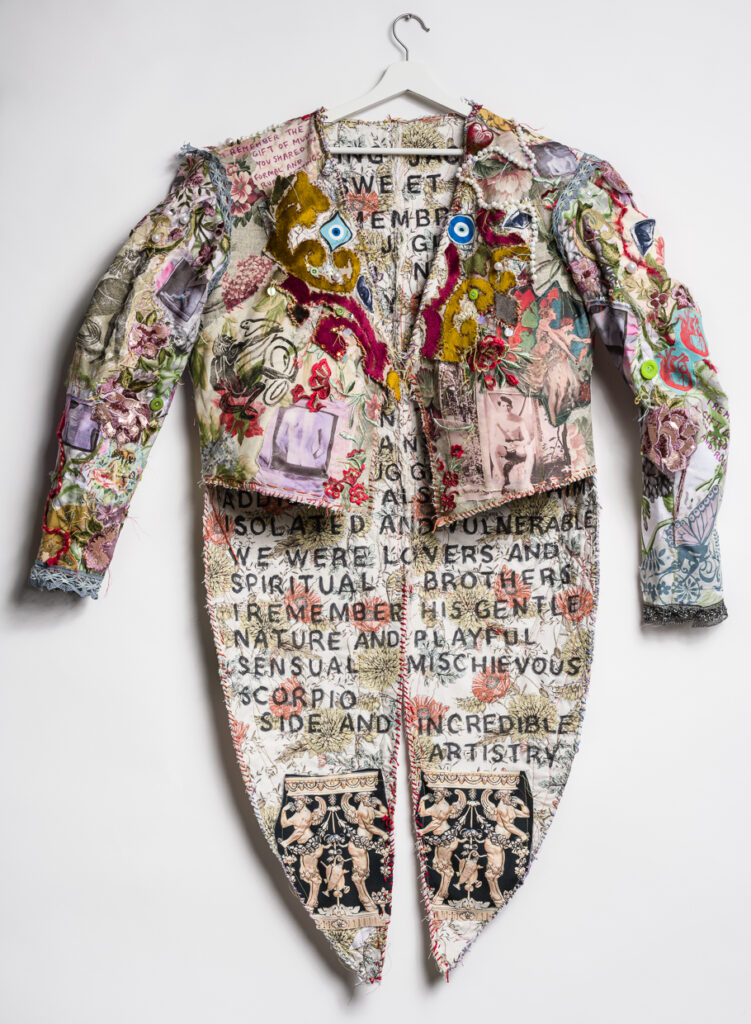
In addition to fabric, you use a lot of other materials. How do you choose them and do they have an intrinsic meaning, a semantic value themselves? And how many are recycled materials?
I’ll admit that I have a pretty keen eye and hand for the embellishments! Living in New York, I do invest in materials through the Garment District businesses when purchasing textiles. Since my work is about bringing small pieces together to create larger forms, I don’t need much yardage of any one fabric, and I think of some of my textile “ingredients” like a cook using saffron, a little goes a long way.
I do repurpose some of my materials, especially as people give me fabric or family items like vintage jewelry or buttons, sewing supplies. I’ve made works that are specifically designed with upcycled components or use alternative materials, but that’s not my main approach, though I greatly appreciate the artists and designers with those intentions more at the heart of their work and practice.
Your works are extremely dense and full of elements. How do they take shape and how do you proceed from the first idea to the finished work? And does this density have an assertive value?
I work on several pieces at a time, sometimes over a couple of years for larger works, as my process is very hand-labor intensive. Sometimes it can be several years before I get to an idea I’d sketched out earlier, but I’m also drawn to starting new things so there’s always lots of pieces “not quite finished,” and other works that come to fruition more promptly. I’ve also started to add some commissioned works to my practice, and those have processes specifically connected to the inspired (and inspiring) patron! I agree that my work is very intensely embellished, layered, one could even describe it as “overworked,” and there are times I consider what a “lighter touch” might mean for me. I really do want all the details to be special, bringing handwork to make every added layer uniquely realized. Use of text is in most of my work, but there are times that I chose not to use words or images as part of an approach to a specific series or piece.
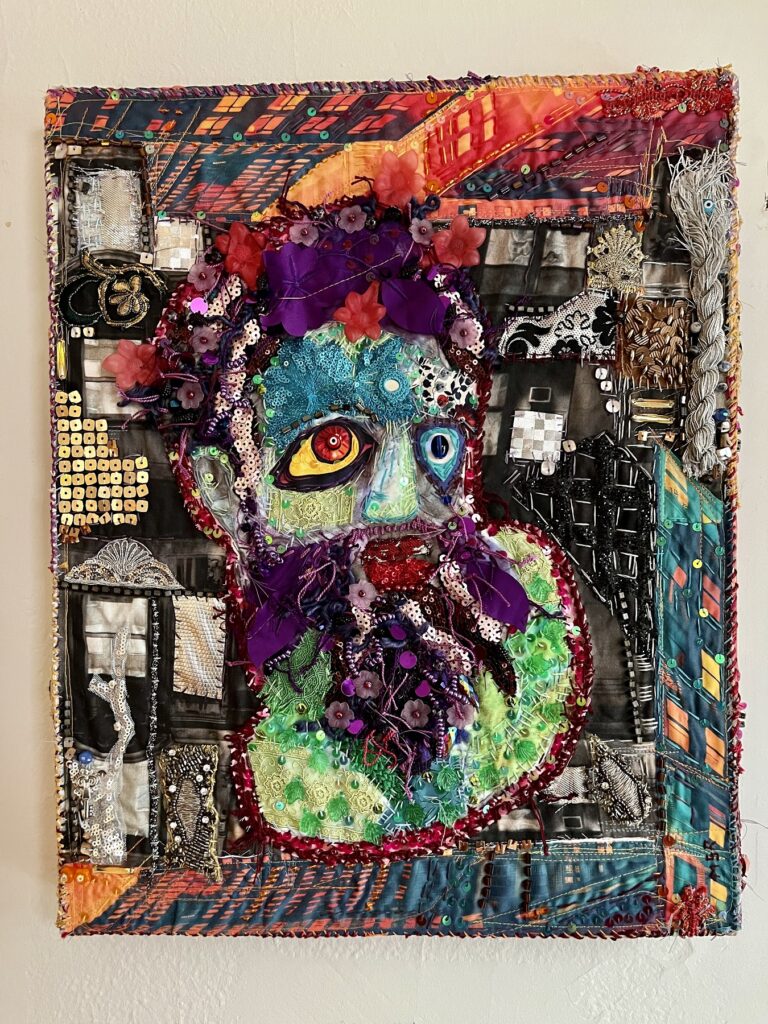
How much are art and life intertwined for you? I feel really fortunate that all of my adult life has been anchored with both art and activism. As an educator, for now thirty-five years, I’ve been able to teach students as young as three all the way through seniors in college across several different art disciplines and several very different institutions. As a creative person, I bring all of my interests and experiences into this work in the world, as an artist, educator, and activist. Still, especially as I’ve grown older, I’m aware that time to make my own art work is really such a precious resource, and that my body is also needing care in ways I probably didn’t understand as a younger person. I’m aware that the repetitive motion of sewing needs to be a more consistent but less demanding practice, while considering how to pace myself with deadlines and time for other self-care and community care initiatives.
What is the work that represents you the most and why? I don’t usually work consciously with self-portraits, but I completed two works that often look back at me from the wall and the pedestal as being very much “me” presences. One of those is the “oracle with beard of keys,” and the other newest work is “Urban Atlas Holding the Weight of the World.” These works are inspired by my recent visits to Pompeii and Rome, and reexamine gender and art histories found in the fragments of the history; I’m considering the the role of the artist navigating the tensions of societies under duress, and creating protective talismans as structures of support for community-engaged rebuilding.
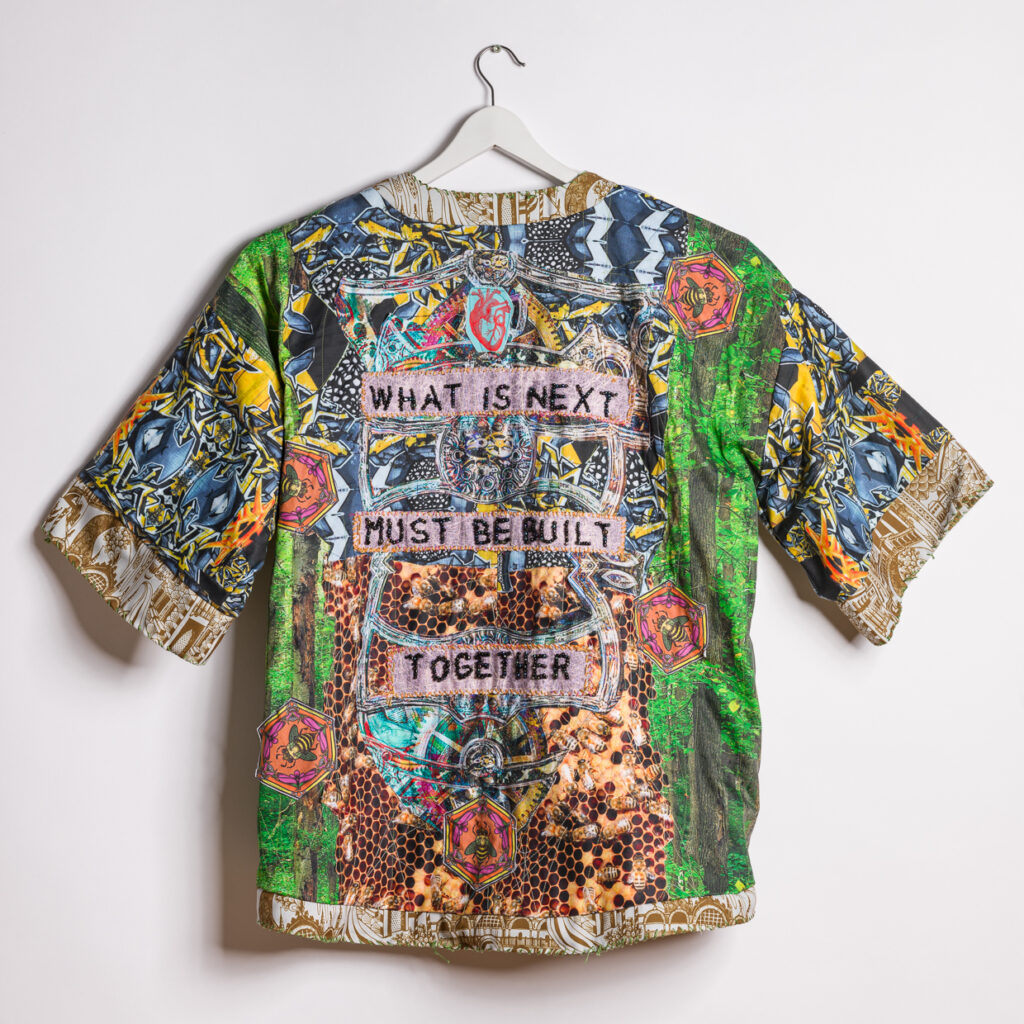
How has your vision, research, and artistic practice evolved over time? Certainly in the last five years or so, I’ve been able to bring my art into museums and gallery settings that have provided a much wider visibility and increased professional resources. In my studio, I’ve added some studio assistants for specific projects, especially for my art fashion work, as a way to complete commissions while also investing in the livelihood of other designers and artisans working with me. I do better compensating their work at an appropriate level than I do for myself, but I’m developing my business model in ways that are rooted in my values and stretching myself to mature in the less creative aspects of life as an artist. I still have a very high impact job as a school administrator, so I’ve learned to be more organized with my time and resources. I’ve been developing art clothing that is more accessible for people to purchase and wear, still one of a kind but more of “pop-up” ready to wear small collections; I love the idea that fellow artists, friends, and community members could be wearing my clothes as special, creative pieces that celebrate the research and themes of my work.
What do you believe is the power of art? Can the work of artists in contemporary society spark reflection, raise awareness, stir consciences, and potentially change the future of humanity, individuals, and communities for the better?
I’ve definitely deepened my work and artistic focus towards community building. In the challenges of this new year, I’ve committed to a couple of curatorial and organizing projects with like-minded fiber artists with a focus of care and resilience amidst the turmoil and challenges of the times in which we live, especially in the resistance to the terrible governmental attacks on civil liberties and the assault on democracy in my country. We’ve seen a retreat from arts institutions that previously supported artists with more political or social justice focused work. I’m determined to keep celebrating LGBTQ+ histories in my work, learning from the ancestors of liberation to further advocacy for a better future. One of my favorite fashion art garments has beautiful beading on the back of the jacket that reads “What Is Next Must Be Built Together,” and I hold that as an intention for the vital activism and collective engagement of artists to help steward the changes needed.
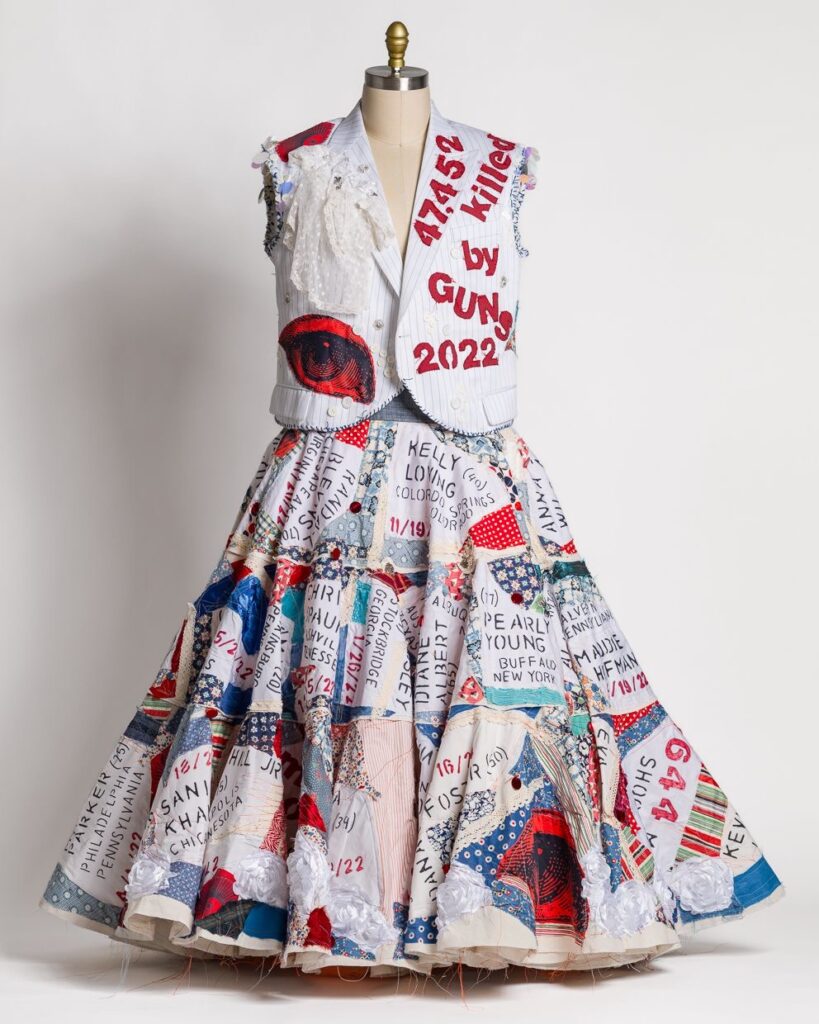
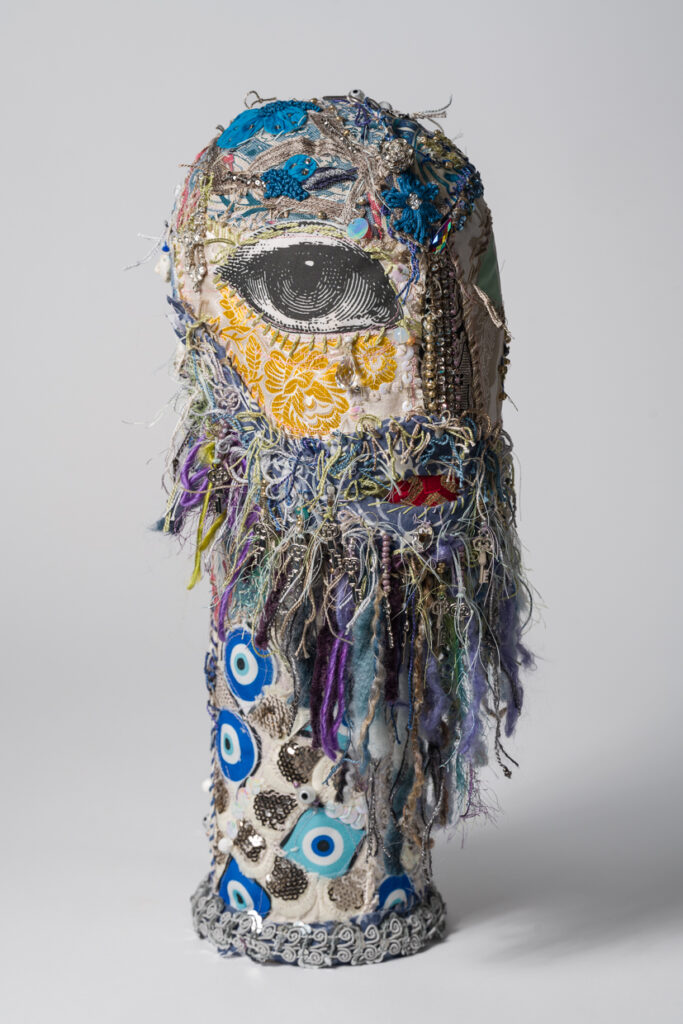
Sylvan is an internationally exhibited genderqueer fiber artist, activist, and prominent leader in arts education. They hold an M.F.A. in Interdisciplinary Arts from Goddard College (2008) and a B.A. from Bennington College (1989), with a focus on dance and drama. With a strong foundation in costume design and performance art, Robinson’s contemporary fiber works have been showcased in prestigious galleries and museum exhibitions. In 2021, their fashion art was commissioned by theater producer and fashion enthusiast Jordan Roth, who wore the piece at the Met Gala. This collaboration garnered significant attention, featured in interviews for both Vogue and Vogue France. Additionally, Robinson was interviewed about fashion art and activism on the Dressed: The History of Fashion Podcast (Episode 239, April 2022). Sylvan is represented by the Contemporary Art Modern Project Gallery in Miami.
Among the main and most recent exhibitions, we highlight: in 2024, Identity Is… Jordan Roth’s Met Gala 2021 Garment designed by Michael Sylvan Robinson was featured in a special installation at the Museum of Arts and Design in New York, New York; Thread of Resistance and Resilience, a solo show by Katrina Majkut, took place at The Iridian Gallery in Richmond, Virginia. In 2023, Threads of Our Time, an international fiber arts exhibition curated by Barbara Pavan and Maurita Cardone, was hosted at the Chelsea Market Gallery in New York; Unconditional Care was held at the Rochester Contemporary Art Center in Rochester, New York, curated by Katrina Majkut. Also in 2023, Center for Arts and History at Lewis-Clark State College in Idaho presented an exhibition curated by Katrina Majkut and Safekeeping, curated by Anita Fields, was showcased at 108 Contemporary in Tulsa, Oklahoma, in 2023. In 2023, Chorus of Twisted Threads featuring artists Sarah Amos, John Paul Morabito, Ramekon O’Arwisters, and Michael Sylvan Robinson was on view at the Patricia Sweetow Gallery in Los Angeles, California. In 2022 Welcome Home, curated by Magdalena Santos and Anne-Laure Lemaitre, took place at the Mojo Supermarket Gallery in Brooklyn, New York and Adorned: Inspired by Fabric and Fashion, curated by Scott Andresen, was on display at the Annmarie Sculpture Garden and Arts Center in Solomons, Maryland. In 2021, Preserve & Protect, curated by Erika Diamond and Michael Dickins, was featured at The New Gallery at Austin Peay State University in Clarksville, Tennessee and Witches Get Stitches, curated by Katrina Majkut, was part of the SPRING / BREAK Art Show in New York, New York, in 2021. Also in 2021, Surface and Depth, curated by Kat Frampton, Felicity Griffin Clark, and Olga Teksheva, was showcased at Palazzo Velli Expo as part of Rome Art Week in Rome, Italy. Patterns, curated by Sarah E. Brook, was exhibited at 440 Gallery in Brooklyn, New York, in 2021. Finally, Remnants, curated by Emily Schlemowitz, was presented at the Wisconsin Museum of Quilts and Fiber Arts in Cedarburg, Wisconsin, in 2021.
